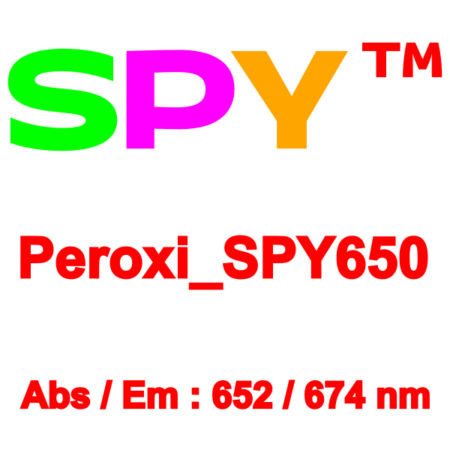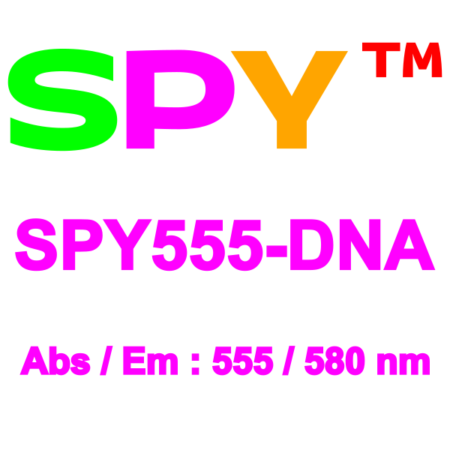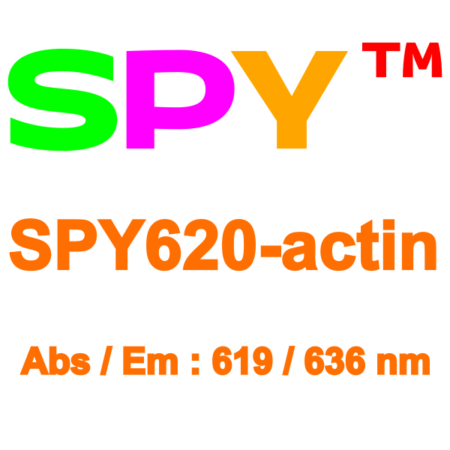Product Description
SPY555-golgi is a bright, orange & non toxic live cell golgi probe based on our SPY™ dyes series. Its optimized structure allows quick labeling of the golgi apparatus in live cells with high specificity and low background. SPY555-golgi stains the golgi apparatus in live cells without the need for genetic manipulation or overexpression of fluorescent proteins. Its absorbance and emission spectra are similar to Cy3. SPY555-golgi enables multicolor imaging with SPY505, SPY595, SPY650, SPY700, GFP or m-cherry. SPY555-golgi can be imaged with standard Cy3 settings. It can be used for, confocal, SIM or STED imaging in living cells and tissue. Contains 1 vial of SPY555-golgi (lyophilized).*
Probe Properties
| Absorbance maximum λabs |
555 nm |
| Fluorescence maximum λfl |
580 nm |
| Works on fixed cells? |
yes |
| Probe quantity |
100 stainings* |
| Fluorescence lifetime |
2.4 ns |
| STED depletion wavelength |
660 or 775 nm |
| Shipping |
room temperature |
| Storage |
-20°C |
*Based on the following conditions: 0.5 ml staining solution / staining experiment with 1x probe concentration. The number of staining experiments can be further increased by reducing the staining solution volume or the probe concentration.
1. Saidbakhrom Saidjalolov et Al. “Asparagusic Golgi Trackers”, JACS Au 2024.
Labeling Information
1.Prepare 1000x stock solution.
Add 50 μL of anhydrous DMSO to the SPY555-golgi vial to prepare the 1000x stock solution (DMSO stock concentration is 300 μM). We recommend using newly or freshly opened and anhydrous DMSO to prepare the 1000x stock solution. In contact with air and moisture, DMSO produces decay products which can strongly reduce the shelf life of the probe in solution, even at -20°C. At this stage, the solution can be colored or not, this has no influence on the performance of the probe. After use, this solution should be stored at -20°C or below. Do not divide the 1000x stock solution into small aliquots, they will decay faster and the probe is not altered by multiple freeze-thaw cycles. When stored properly, this stock solution is stable for 3 months.
2. Prepare the staining solution.
Dilute SPY555-golgi to 1x (i.e. a final concentration 300 nM) in your usual cell culture medium (e.g. DMEM + 10% fetal bovine serum) and vortex briefly. If the dilution is not performed in a single step, please use DMSO to prepare the intermediate dilution as using aqueous buffers to prepare the intermediate dilution may lead to the formation of probe aggregates. Proceed quickly to step 3. Since staining efficiency can depend on the cell line, it is recommended to stain cells with 1000x dilution at the first attempt and then optimize the SPY650-golgi dilution factor in further experiments until an optimal staining is achieved. Use only freshly made staining solution, and do not use it multiple times.
3. Cell preparation and staining.
3.1 Live cell staining: Grow cells on coverslips, glass bottom dish or glass bottom multi-well plates as usual. When cells have reached the desired density, replace the culture medium by the staining solution freshly prepared under step 2 ensuring that all the cells are covered with the solution. Place the cells in the incubator at 37°C in a humidified atmosphere containing 5% CO2 for 15-30 minutes*. Perform a simple washing step consisting of replacing once the labelling solution by fresh culture medium which does not contain the probe.
3.2 Fixed cell staining: Grow cells on coverslips, glass bottom dish or glass bottom multi-well plates as usual. When cells have reached the desired density, the cells should be stained first with SPY555-Golgi as described in in step 3.1 and then fixed with 4% formaldehyde or 2% glutaraldehyde using standard protocols. Post fixation staining cannot be performed, SPY555-Golgi needs to be metabolically palmitoylated within the live cells to properly localize to the golgi.
4. Cell imaging.
Imaging of SPY555-golgi is best performed using standard Cy5 settings. Ca 3-4 hours after the staining, the signal intensity drops by 50%. Therefore the probe should not be used for timelapse experiments exceeding 4h.
Important Note:
This protocol was optimized and validated using HeLa, MDCK, MCF-7, or RPE-1 cells adhering to coated glass or polymer dishes. For other cell lines, recommendations in this protocol should be used as a starting point, and optimal labeling conditions for each cell type should be determined empirically. High concentrations/long incubation times result in saturation of the golgi and leakage of the fluorescent signal into ER/endomembranes. Reducing the probe concentration or staining time by half usually results in a bright and golgi specific signal.
* The recommended labelling time weas determined for 2D cultured cells and may differ slightly depending on the cell line used or the sample type (e.g. spheroids, organoids or tissue).









